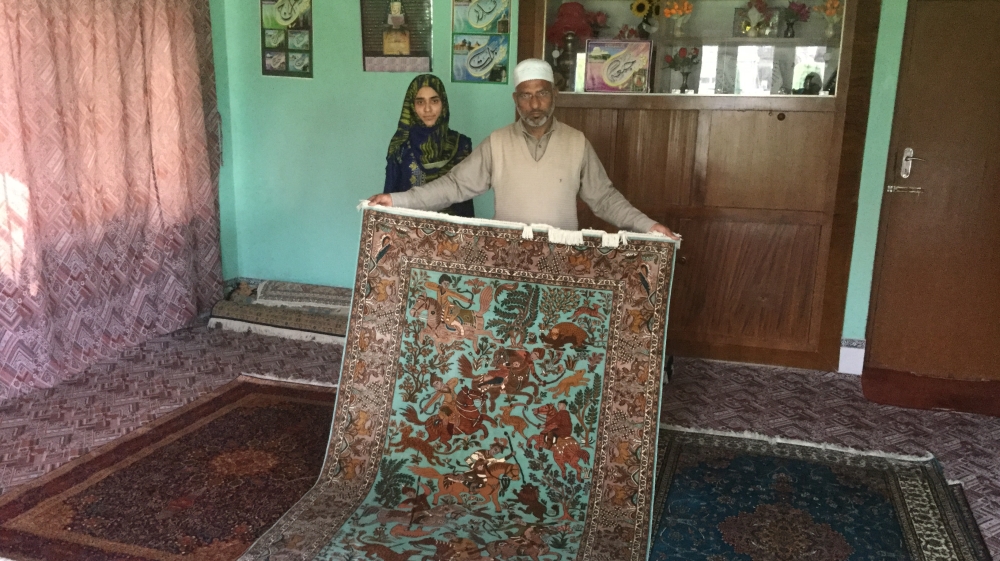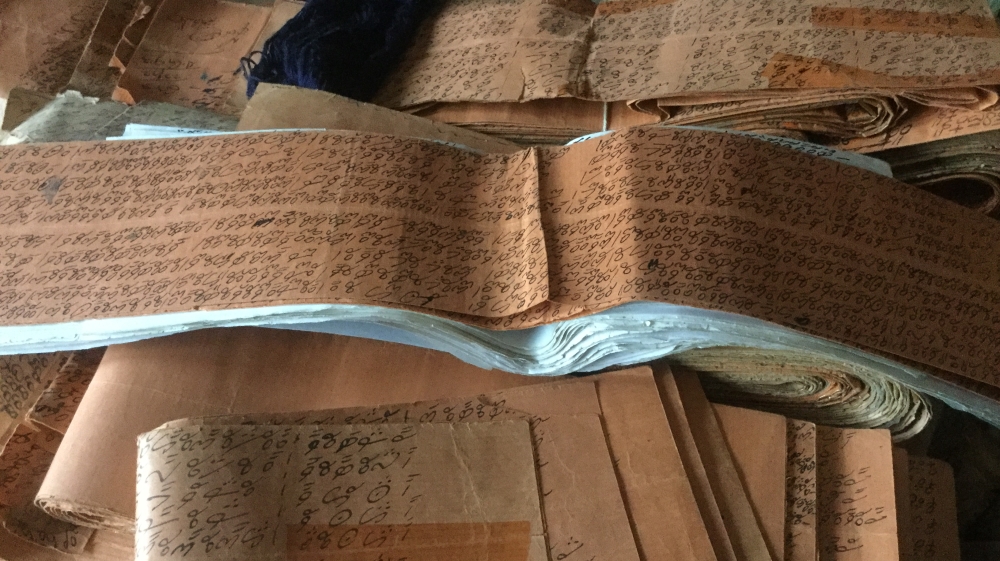The rise of the machines: Kashmir’s weavers fear for their future
Mechanisation and competition from China and Iran are disrupting Kashmir’s ancient crafts – and hurting livelihoods.

Srinagar, Indian-administered Kashmir – As he puts the finishing touches on a delicate, woven mauve pashmina wool shawl that has taken around three months to make using ancient skills, Mehrajdin Dar says he has bittersweet feelings about the end of this particular project.
For his work, he will be paid slightly less than $290. Similar shawls can sell for up to 10 times that online.
Keep reading
list of 4 itemsNigeria’s women drivers rally together to navigate male-dominated industry
‘I blame the government’: Poor Kenyans say no support amid record flooding
‘We need you’: Solomon Islands’ support for US agency’s return revealed
On a wooden loom next to him is his father, Ghulam Ahmed Dar. He has been weaving a silk carpet and earns about $57 a month, also a fraction of the final retail price of one of his products.
Like a growing number of people in this politically unstable valley, the Dars worry that weaving will not be able to sustain them for long. As artificial intelligence and robots threaten jobs in the developed world, Kashmir’s artisans are struggling to cope with the mechanisation of their work. And in both places, globalisation is also taking its toll.
Shawls and carpets made by machines in Kashmir – and increasingly also in China and Iran– are a lot cheaper than, and are being passed off as, handcrafted ones. The craft of so-called kani pashmina weaving has been passed down through generations since the 15th century, but is now slowly dying out as young Kashmiris are no longer eager to take up the work of their forefathers.

“Even unskilled labourers earn more in a day than the rates we earn making carpets and shawls. There’s no point ruining your eyes and breaking your back for such pathetic sums,” Mehrajdin Dar told Al Jazeera.
To make a pashmina shawl, high-quality wool first needs to be spun into yarn, dyed and then woven on a loom into the final product. Traditionally, the entire process would have been done by hand, but now, machines can spin yarn and weave it into the final product more efficiently. Ask any artisanal weaver here, however, and he or she will tell you its quality just is not the same as what they would make by hand.
‘Handmade’ by machine
Despite the quality of handmade products, figures from the latest available government census show that the number of weavers is dwindling. In 2016-17, around 10,000 Kashmiris were engaged in shawl making, less than a tenth of the 100,300 weavers in 2007-08.
But even as the number of artisans has fallen, the volume of shawls being made has grown, suggesting that many of the products labelled as “handmade” are actually being churned out by machine. According to the census, the Kashmir region produced shawls worth $124.6m in 2016-17, up from $96m in 2014-15. Many manufacturers here say the official data significantly underestimates the volume of shawl production.

“The handloom sector is facing multifaceted challenges primarily due to machine-made fabric, cheaper and quality synthetic substitutes and changing consumer tastes that have put a serious constraint in the development of this sector,” said the Jammu and Kashmir state government’s Economic Survey in 2017.
Dealers in Srinagar say the growing demand for shawls globally can not be met by artisans, and that the number of power looms in the region is growing rapidly.
“Earlier, shawls made outside Kashmir on power looms were sold as handmade Kashmiri pashminas,” an exporter in Srinagar told Al Jazeera on condition of anonymity.
“But [with] the greed for profits, and with supplies of hand-spun yarn and hand-woven shawls falling short of the growing demand, it has led to a proliferation of power looms in Kashmir, threatening the handloom tradition,” the exporter said.
He estimates that between 75 percent and 95 percent of the pashmina shawls coming from Kashmir are made on power looms that operate illegally.
It is a similar story for the local carpet industry.
Many of the products that get passed off as Kashmiri handcrafted rugs are made by machines, not in Kashmir, but in Iran and China, Farooq Shah, secretary-general of the Kashmir Carpet Manufacturers Association, told Al Jazeera. Some of these are sold in Europe, but they are also sold in Kashmir itself, he says.
Working simultaneously, two weavers can take up to 12 months to turn in a hand-knotted 1.2 metre-by-1.8 metre silk rug. A machine can make a similarly sized piece in less than three hours. Chinese and Iranian machine-made carpets cost less than $100 for every square meter. Kashmiri hand-knotted silk rugs, on the other hand, cost many times that.

“Carpets imitating Kashmiri patterns made on machines in China with inferior silk have flooded the global markets. My warehouse has several unsold carpets waiting for buyers for three to four years,” Iram Shalbaf, a carpet manufacturer in Srinagar, told Al Jazeera.
The latest available government figures show that handcrafted carpets worth $52.8m were exported from Kashmir in 2016-17, down from $70.3m during the 2014-15 period.
‘The menace’
Carpet makers’ association chief Shah says competition from automated carpet makers in China and Iran is endangering the livelihoods of around 130,000 Kashmiris engaged in the industry. In addition to weavers, the traditional cottage industry employs designers, dyers, washers and traders.
“If somehow, machine-made carpets – once imported into India – could be tracked, the menace can be checked,” he says.

Kashmir’s weaving industry leaders say a more robust form of certification could help protect artisans, especially shawl makers.
In 2005, the government introduced a geographical indication certificate to distinguish pashmina products made by hand in Kashmir from machine-made variants. But it proved to be unworkable.
The certificates were reserved for makers of shawls woven by hand from hand-spun pashmina yarn. But few artisans made the grade. The Srinagar exporter says that even if artisanal shawls are woven by hand, most pashmina yarn today is spun by machine.
“Shawls made on machines should be tagged as machine-made instead of being passed off as handmade. Wrong labelling is diluting ‘brand Kashmir’. We can only blame ourselves,” Shah said.
To ensure that genuine handcrafted pashmina gets priced accurately by the market, stringent labelling rules enforced effectively are required, exporters and weavers say. Without such drastic measures, the heritage of handmade shawls may not survive for long.
And the weavers themselves need to get a bigger share of the profits. Disintermediation – cutting out exploitative middlemen – would greatly help to achieve this, industry experts say.
The Jammu and Kashmir state government has set a target to increase exports by $142.5m a year through disintermediation.

But even with such measures, the traditional crafts of the region appear to be fading away as young people choose less physically demanding, higher-paying jobs.
“Young Kashmiris no longer find the pashmina handicraft lucrative and are striving for other professions. There’s a loss of sense of pride in the pashmina culture because of the exploitative nature,” says Ishfaq Ahmed, a youthful-looking manager in a Srinagar hotel.
Ahmed says few people in his village of Kunzer Tehsil practise the craft any more. Most of them want jobs overseas and they regard professions such as engineering as being more respectable than weaving.
But things were very different even until just a few years ago, when the machines started taking over, Ahmed says.
Women in almost every household of his village would spin pashmina, he says. The handicraft was a cultural heritage and an assured – even if meagre – source of earnings.
For generations, men and women across the Kashmir Valley would switch to shawl and carpet making during the harsh winters, when their farms and orchards were buried under snow.
Despite working five to six hours a day for three or four months at a stretch, the artisans received no more than around $570 for one shawl or carpet. That, says Ahmed, is no longer enough to make young Kashmiris want to learn the craft.